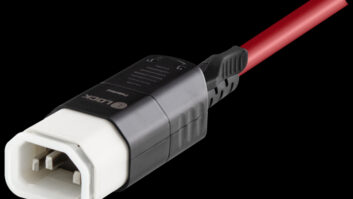

Some of the bigger microphone manufacturers in the world have developed and sold mixers to blend together the signals from their mics (among others), and in particular, in the world of installed sound, corporate AV, and other related areas, we have seen some great rackmount mixers, typically used to blend gooseneck, boundary, and podium mics in a business environment. Over time, these mixers started to become more sophisticated with better equalization, dynamics processing, and eventually even automixing capacities.
AKG introduced its DMM 4/2/2 digital automixer in 2009, followed by the DMM 4/2/4 in 2010, and most recently, the DMM6. As you might imagine, the DMM6 offers six inputs, and each can introduce mic or line level signals to the mix. It also offers signal processing, including automixing, and can be remotely controlled. AKG have also introduced DMM12 and DMM12 BC models, each offering 12 inputs, and additional analog and digital output options in the BC version. I evaluated a DMM6, and found it to be a solid performer.
The DMM12 versions of AKG’s mixer squeeze 12 channel-control knobs into a single rack-space front panel (and successfully so, due to their diagonal staggering and very narrow knob diameter). The front panel of the DMM6 appears very stark because it’s essentially the same as the 12-channel versions, but with six channel knobs stripped away. I really like these skinny knobs and their wide dispersion; this makes it very easy to grasp and turn them, a typical difficulty with single rack-space devices. Surrounding each channel knob is a ring of LEDs to display parameter levels and realtime input level metering. The channel knobs facilitate data input for more than just gain, namely, parameters pertaining to treble, bass, low cut, compression, automixing, priority, pan, delay, output routing, record routing, monitoring, and muting. Each knob is also a pushbutton that toggles on or off the digital signal processing function currently selected by an additional knob located to the right of the six channel knobs. This system control knob is also a pushbutton and determines which of the parameters is adjusted by the channel knobs and also selects other system control modes—balance for the stereo output mix and three unused options (A, B, and C) reserved for implementation of other functionality in the future. To the right of the system control knob are level knobs for overall system output and the unit’s 1/4in. headphone jack. There is also a stereo eight-segment LED level meter beneath the main output knob, displaying the level of the final output. The controls can be selectively locked and parameters can be copied and pasted from one channel to others, as well. I found the front panel very informational and easy to use with the slender, spaced-out knobs—definitely important to me.
The mixer’s rear panel features, from left to right, six female XLR connectors representing the unit’s channel inputs, each with a knob determining input gain, and a slider switch per pair of inputs toggling on and off phantom power for its associated pair. The gain knobs have a detent at the counterclockwise extreme of their throw to indicate, in a tactile fashion, that gain is at its minimum of 0dB. To the right of the input jacks are two male XLR connectors representing the mixer’s main stereo output, followed by a stereo pair of RCA jacks that present the mixer’s discrete recording output. Continuing to the right, there are a pair of RJ-45 Ethernet ports for system expansion or cascading of multiple units, followed by a DB-9 jack for control of the mixer via the RS-232 serial protocol. A pair of Phoenix terminals to its right facilitates external grounding and the use of an external potentiometer for master level control. Finally, at the rightmost end of the rear panel is an IEC AC power inlet and a rocker power switch. I have one minor critique regarding the rear panel: AKG could have chosen the specialized XLR inputs that also accept 1/4in. TRS plugs, facilitating direct connection of line-level signals and eliminating the necessity of a direct box for each line-level signal the user wishes to include.
The DMM6 offers a useful selection of digital signal processing to facilitate further manipulation of the input signals. There are treble and bass shelving EQ, offering ±14dB of boost/cut in 2dB increments above 10kHz and below 100Hz, respectively. A second-order low-cut (high-pass) filter is available, sweepable from 10Hz to 150Hz, in 10Hz increments. A limiter is available for application to the stereo output bus, with onset threshold adjustable from 20dB to -25dB in 3dB increments. Similarly, compressors are available per input channel with a ratio of 2:1 and onset threshold variable from 20dB to -25dB in 3dB increments, just like the output limiter. Input channels can be panned in the stereo image, and the stereo output can be balanced, left to right. Channel signals can also be delayed by up to 75 milliseconds in 5-millisecond increments, and whether input channels are routed to the main stereo bus, record bus, or both is also determined by input from the channel control knobs.
The system’s automixing algorithm is based on three functions, dynamic level adjustment, “best mic on,” and noise detect. Dynamic level adjustment constantly monitors ambient room noise and calculates a reference value. Signals below this threshold are considered noise and are attenuated heavily, while signals above it are considered to be dominant and are only slightly attenuated. This process leverages a gain-sharing scheme to prevent levels from getting too high and helping to avoid feedback. If one speaker’s voice is picked up by two microphones, the “best mic on” function assesses which is higher in level and mutes the lower of the two in order to avoid comb filtering, which negatively impacts clarity. Finally, the noise detect function isolates uninterrupted signals that are otherwise loud enough to be assessed as dominant (air conditioning, for instance) and precludes them from being considered in determining which mics to open. A single channel (likely for a chairman or meeting leader) can be assigned as a priority channel, giving it a 6dB advantage in determining selection.
Up to 10 DMM6 units can be cascaded together to expand the number of available input channels up to a maximum of 60. Control over the entire system of networked units can be assigned to the automix algorithm of a single unit—very handy, for instance, when a contractor needs to simply expand the number of mics in a meeting room. AMX and Crestron-style serial control is also available via the RS-232 interface on the DMM6 rear panel. Although serial control is getting long in the tooth at this point, this is still helpful, because there will certainly be clients who wish to maintain the controls they know and love but may want to update to digital mixing, with its superior DSP and automixing capacities.
The DMM6 is easy to integrate, easy to configure, and easy to tweak as necessary after the fact. Its digital signal processing sounds great and grants effective control over timbre and output level. Its scalability via cascading is also welcome, and the ability to retain familiar serial control systems will be popular with many clients. AKG is clearly looking ahead with the three available switch positions earmarked for future functionality. The DMM6 is sturdy, delivers excellent fidelity, and provides effective automixing with useful signal processing just as promised. It should be on the list of automixers you’ll consider if you’re in the market.
PRODUCT SUMMARY
Pros: High quality mic mixer with great automixing and signal processing and routing
Cons: Lack of 1/4in. line-level inputs, forcing use of direct boxes
Applications: Corporate meeting, conference, any spoken word application
Price: $1,666
SPECIFICATIONS
Dimensions (WxHxD): 483mm x 44mm x 203mm
Weight (with packaging): 3.5kg
Permissible operational ambient temperature: + 5 to + 45°C
Minimum operational humidity: 20%
Maximum operational humidity (non-condensing): 83%
Input voltage: 100 to 240VAC
Mains frequency: 50 to 60Hz
Maximum power consumption: 75W
Output voltages: +5VDC / +12VDC / -12VDC
Balanced inputs – preamp
Gain: 0dB to 57dB
Maximum input level: +20dBu
Common-mode rejection: > 70dB
Dynamic: > 120dB
Signal/noise ratio (S/N): 90dB
Input impedance: > 8kΩ
Equivalent input noise: -127dBu
Balanced inputs – phantom power
Phantom power: +48VDC
Maximum supply current per input: 10mA
Feed resistances: 2 x 6.8 kΩ
Balanced inputs – Analogue Digital Converter
Outputs
Data format: 24-bit
Sample frequency: 48kHz
Recording and master output
Maximum output level: +20dBu
Dynamic: > 110dB
Signal/noise ratio (S/N): 90dB
Minimum load impedance: < 100Ω
Digital analogue conversion for recording, monitoring and master output
Data format: 24-bit
Sample frequency: 48kHz
John McJunkin is the principal of Avalon Podcasting in Chandler, Ariz., and produces and co-hosts a top-rated morning radio talk show in Phoenix. He has consulted in the development of studios and installations, and provides high-quality podcast and voice production services.










